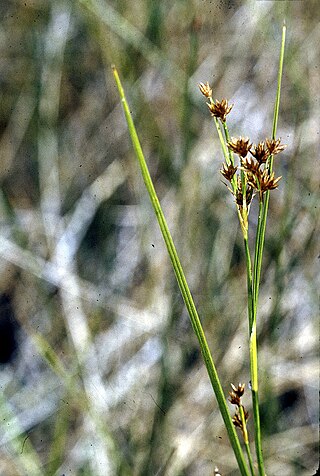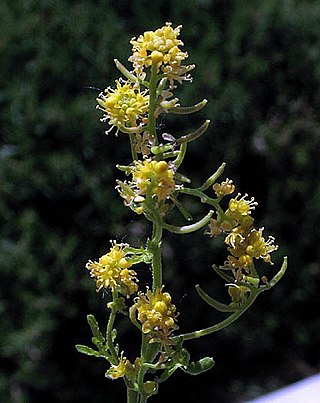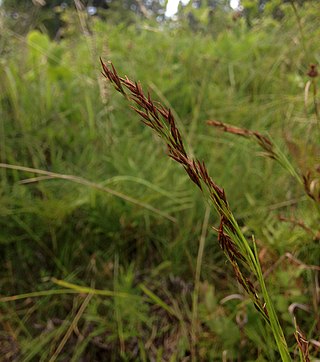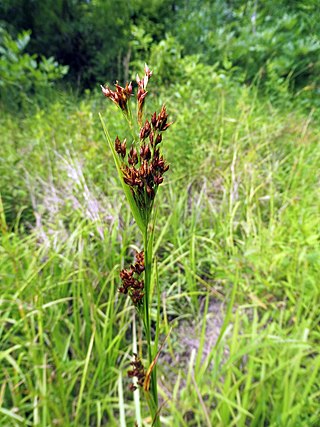
Rhynchospora is a genus of about 400 species of sedges with a cosmopolitan distribution. The genus includes both annual and perennial species, mostly with erect 3-sided stems and 3-ranked leaves. The achenes bear a beak-like tubercule and are sometimes subtended by bristles. Many of the species are similar in vegetative appearance, and mature fruits are needed to make a positive identification.

Allium validum is a species of flowering plant commonly called swamp onion, wild onion, Pacific onion, or Pacific mountain onion. It is native to the Cascade Range, the Sierra Nevada, the Rocky Mountains, and other high-elevation regions in California, Oregon, Washington, Nevada, Idaho and British Columbia. It is a perennial herb and grows in swampy meadows at medium and high elevations.

Stuckenia pectinata, commonly called sago pondweed or fennel pondweed, and sometimes called ribbon weed, is a cosmopolitan water plant species that grows in fresh and brackish water on all continents except Antarctica.
Carex sheldonii is a species of sedge known by the common name Sheldon's sedge.
Crepis pleurocarpa is a North American species of flowering plant in the family Asteraceae known by the common name nakedstem hawksbeard. It is native to the western United States (Washington, Oregon, northern California and western Nevada.

Spiranthes cernua, commonly called nodding lady's tresses, or nodding ladies' tresses, is a species of orchid occurring from Maritime Canada to the eastern and southern United States. As the common name suggests cernua means "nodding", or "bowed" in Latin.

Pulicaria dysenterica, the common fleabane, or, in North America, meadow false fleabane, is a species of fleabane in the family Asteraceae. It is native to Europe and western Asia where it grows in a variety of habitats ranging from semi-arid Mediterranean woodlands to wetter situations. Pulicaria dysenterica is perennial and can form dense clusters of plants, spreading by its roots. It flowers at its maximum height of about 60 centimetres (2.0 ft). Leaves are alternately arranged and clasp the stem, which itself contains a salty-astringent liquid. The yellow inflorescences are typically composed of a prominent centre of 40–100 disc florets surrounded by 20–30 narrow, pistillate ray florets. When setting seed the flower heads reflex.
Psilocarphus oregonus is a species of flowering plant in the family Asteraceae known by the common names Oregon woollyheads and Oregon woolly marbles. It is native to western North America from Washington and Idaho to Baja California, where it grows in seasonally wet habitat, such as vernal pools.

Ranunculus eschscholtzii is a species of buttercup flower known by the common name Eschscholtz's buttercup.

Rhynchospora capitellata is a species of sedge known by the common names brownish beaksedge and brownish beaked-rush. It is native to eastern North America and a few spots in the western United States. It grows in wet habitat, such as swamps, springtime meadows, and moist areas in forests. It is a perennial herb producing clumps of stems 20 to 100 centimeters tall, each stem sheathed with several narrow, pointed leaves. The inflorescence is a cluster of brown spikelets each about 3 or 4 millimeters long.

Rorippa curvisiliqua is a species of flowering plant in the family Brassicaceae known by the common name curvepod yellowcress.

Rhynchospora knieskernii is a rare species of sedge known by the common name Knieskern's beaksedge. It is endemic to the state of New Jersey in the United States, where it occurs naturallyin the Pine Barrens. Reports have cited it present in Delaware as well, but these populations appear to have been introduced. It is threatened by the destruction and degradation of its habitat. It is a federally listed threatened species of the United States.

Erigeron grandiflorus is a North American species of flowering plant in the family Asteraceae known by the common names Rocky Mountain alpine fleabane and largeflower fleabane.

Erigeron poliospermus is a species of flowering plant in the family Asteraceae known by the common names gray-seeded fleabane, purple cushion fleabane, and hairy-seed fleabane. Native to western North America, it is mainly found to the east of the Cascade Range in Washington, Oregon, and Idaho.
Helianthus heterophyllus is a species of sunflower known by the common names variableleaf sunflower and wetland sunflower. It is native to the coastal plain of the southern United States from Texas to North Carolina.

Lactuca ludoviciana, the biannual lettuce, is a North American species of wild lettuce. It is widespread across much of central and western Canada and the western and central United States from Ontario west to British Columbia and south to Louisiana, Texas, and California. Most of the known populations are on the Great Plains; populations west of there may well represent naturalizations.

Carex rariflora, the looseflower alpine sedge, is a species of plant in the sedge family. It is found in the United States in Alaska and Maine, and in Canada in New Brunswick and Nova Scotia. In these regions, it is ranked as an obligate hydrophyte in establishing wetland areas. It prefers wet environments such as open bogs, meadows, seepage slopes, and low-elevation heath tundra. This perennial grass, which can be up to 3 feet tall, has fibrous roots, and holds all perennial organs underground. The leaves are alternate, long, narrow, and simple, with parallel veins. They grow in dense clusters, and the dead leaves are found at the base of the plant. The plant blooms and fruits in the summer. All flowers are monoecious and unisexual, producing a spike inflorescence. All inflorescences are subtended by shorter, proximal bracts.

Rhynchospora rariflora, commonly called fewflower beaksedge, is a species of flowering plant in the sedge family (Cyperaceae). It is native to North America, where it is found in the southeastern United States, Mexico, Belize, Honduras, Nicaragua, and the West Indies. Its typical natural habitat is sandy or peaty areas, in wet savannas, seeps, and bogs.

Rhynchospora inexpansa, commonly called nodding beaksedge, is a species of flowering plant in the sedge family (Cyperaceae). It is native to North America, where it is found in the southeastern United States and West Indies. Its typical natural habitat is in moist meadows, flatwoods, and pond edges. It is a weedy species that responds positively to ecological disturbance.

Rhynchospora caduca, commonly called anglestem beaksedge, is a species of flowering plant in the sedge family (Cyperaceae). It is native to North America, where it is found in the southeastern United States. Its typical natural habitat is in low, wet areas, such as in marshes, seeps, tidal swamps, pine savannas, and flatwoods.
















